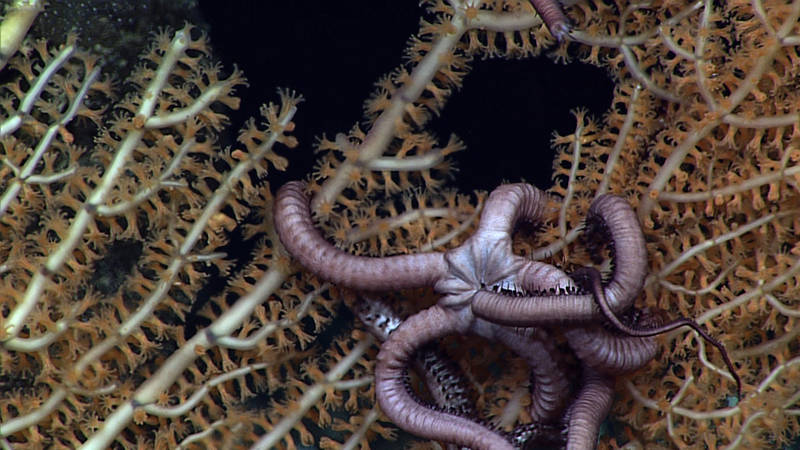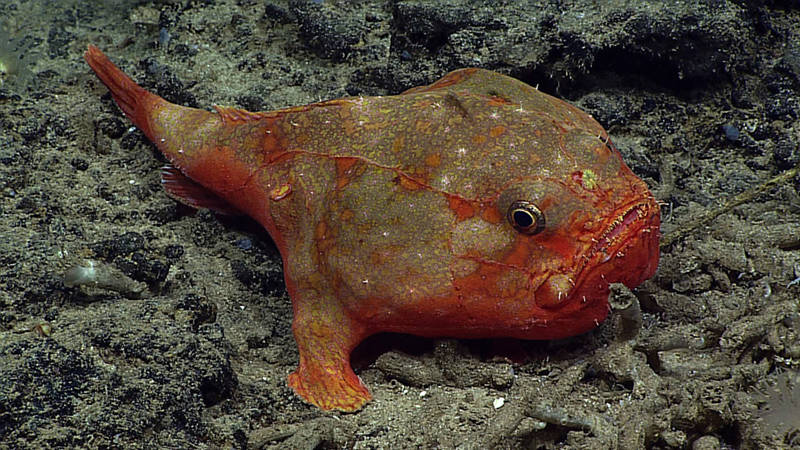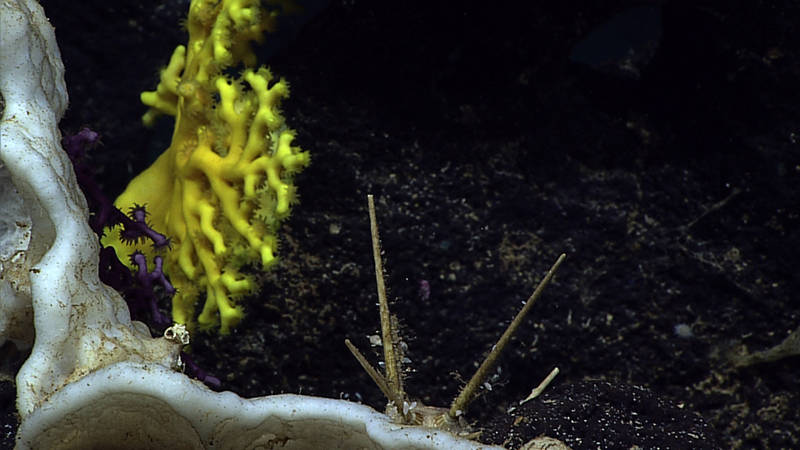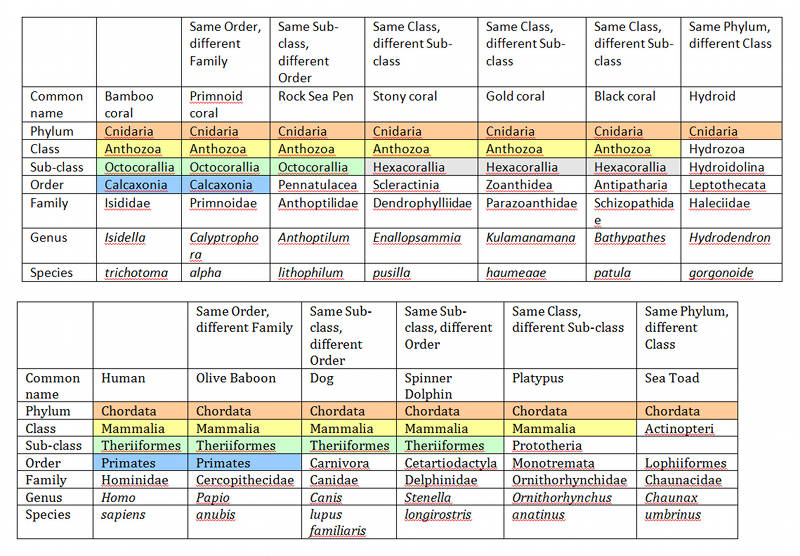
By Scott C. France - University of Louisiana at Lafayette
September 19, 2015

Close-up of a bamboo coral with an ophiuroid brittle star intertwining its arms around the branches of the colony. The photo was taken at 507 m depth off the SW tip of Ni’ihau. Image courtesy of the NOAA Office of Ocean Exploration and Research, 2015 Hohonu Moana. Download larger version (jpg, 1.3 MB).
If you follow along with the video stream and listen to the scientists describe the features and animals that appear, you’ll hear many unfamiliar, complicated, and foreign-sounding names. Welcome to the world of scientific nomenclature!
Why does it have to be so complicated? Why is it not sufficient to simply say “coral” or “eel” or “shrimp?” Scientists are not trying to speak in a secret code or sound overly [smugly?] intellectual. Rather, our goal is to be precise and to convey the most meaning with agreed-upon terminology, the so-called jargon of our fields. Much of what science students learn in their basic courses is the language of the specific field of interest.

Two large octocoral sea fan colonies grow off the side of a rocky feature at 391 meters off the southwest tip of Ni’ihau. The colony on the left is a bamboo coral (genus Isidella) and on the right is a primnoid (genus Calyptrophora). The red dots of the remotely operated vehicle Deep Discoverer's lasers are visible near the center of the bamboo coral colony. The lasers are 10 centimeters apart and are used for estimating sizes. This colony is greater than 120 centimeters wide and at least 60 centimeters tall. Image courtesy of the NOAA Office of Ocean Exploration and Research, 2015 Hohonu Moana. Download larger version (jpg, 1.1 MB).
One of the goals of the current expedition, and those of the overall three-year CAPSTONE project in the Central Pacific, is to learn more about the biodiversity of the deep-sea hard bottom in this region. Biodiversity can mean many things, but we’ll consider it in its most basic meaning: species richness, a measure of the number of different species.

Several rock pens – a type of sea pen adapted to live on a hard bottom by modifying the peduncle (the large swollen structure at the base) into a form of suction-cup – grow alongside a precious pink coral, Pleurocorallium secundum, at 433 meters depth off the southwest tip of Ni’ihau. A neon blue fish, Epigonus glossodontusis, can be seen swimming past the lower edge of the Pleurocorallium. Image courtesy of the NOAA Office of Ocean Exploration and Research, 2015 Hohonu Moana. Download larger version (jpg, 1.5 MB).
Higher (greater?) biodiversity means greater complexity in communities: more biological interactions, such as predator-prey or host-symbiont; more variation in physiology, adaptations, and responses to pathogens and the physical environment; more structural variation to the habitat – big animals, small animals, animals that provide habitat for other animals (such as coral colonies do with their branches); etc.
Using common names may obscure the actual biological diversity represented by the name. A good example is when you buy fish called “snapper” at the market – it may represent any one of 200 different species! Furthermore, common names vary from place to place and person to person. What is commonly referred to as onaga in Hawaii is called Long-Tail Red Snapper elsewhere in the United States. Common names also vary regionally with language - in fact, onaga is a Japanese name, the Hawaiian name is `Ula`ula koa`e - but scientific names, rooted in Latin and Greek, are the same across all languages. Finally, many of the deep-sea animals we encounter have no common names because they are so poorly known.

Several colonies of the hydroid Hydrodendron gorgonoide extend from a rock at 566 m depth off the SW tip of Ni’ihau. Two squat lobsters can be seen in their branches. Image courtesy of the NOAA Office of Ocean Exploration and Research, 2015 Hohonu Moana Download larger version (jpg, 1.7 MB).

The sea toad, Chaunax umbrinus, a type of deep-sea angler fish, was seen at 328 meters depth off the southwest tip of Ni’ihau. The yellowish frilly structure in the center of its forehead is used as a lure. Image courtesy of the NOAA Office of Ocean Exploration and Research, 2015 Hohonu Moana. Download larger version (jpg, 1.7 MB).

Two different species of stony coral, both in the genus Enallopsammia, one purple and one yellow, grow next to one another. In the foreground is the edge of a sponge, from behind which extend the thick spines of a cidarid sea urchin. The photo was taken at 477 meters depth off the southwest tip of Ni’ihau. Image courtesy of the NOAA Office of Ocean Exploration and Research, 2015 Hohonu Moana. Download larger version (jpg, 1.1 MB).
Another element of biodiversity is how evolutionarily different the species in a community are, and a shorthand for this sort of comparison is the taxonomic classification of the species. So during the dives, we may refer to a particular animal by its species name, or genus name, or family name, etc. And by understanding something about these classification levels, you can begin to appreciate just how evolutionarily distant some of these corals are from each other.
Using the bamboo coral Isidella trichotoma as an example, a comparison between this species and Calyptrophora alpha – another octocoral in the same taxonomic order (Calcaxonia, highlighted by shared blue color in the chart below) but in a different taxonomic family - is about the same level of comparison between a human and an Olive Baboon, which are both in the order Primates (highlighted by shared blue color in the chart below) but in different families. Looking across more widely-separated evolutionary branches, comparing a bamboo coral to a sea pen – both octocorals (highlighted by shared green color) but in different taxonomic orders - is like comparing a human to a dolphin or a human to a dog (or a dog to a dolphin)! Comparing bamboo corals to black corals crosses an even greater evolutionary jump, from one sub-class to another, on par with humans to platypus. These are very different animals1! Finally, in comparing a hydroid colony to an octocoral colony, we are looking between classes, and so in our analogy it would be at the level of humans (Class Mammalia) to fish (Class Actinopteri).
So, although it may sometimes sound like we are using pretentious language to refer to many variants of corals, the precision of scientific language allows us to intuit the biodiversity and evolutionary divergence the corals represent - as taxonomically great as the divergence between humans and fish2 - without having to discuss this aloud each time.

A chart to illustrate the taxonomic classification levels of some deep-sea corals as compared to mammals. In each table, shared color indicates belonging to the same taxonomic group.
Note that species that are in different families must also be in different genera, and those in different orders must be in different families and genera, etc. This is the hierarchical nature of the classification: if the higher level is different between a pair of animals, so too must all the levels below it. But each family may have multiple genera, just as each genus may have multiple species. Thus the analogy to a tree: different leaves (species) may arise from the same branch (genus), and the many branches with their leaves represent different genera and species. Each level above genus is effectively a bigger branch on the tree leading back to the biggest branch (here phylum) that sprouts from the tree trunk. Leaves on smaller branches arising from the same larger branch are more closely related to each other, that is, more recently split or diverged from the main branch, than they are to leaves on other large branches on the tree.
Classification levels are rapidly changing as we learn more about the evolutionary history of life using newer technologies, eg. the molecular genetic revolution. For the illustrative purposes of this essay, I am using the familiar system based on the classification hierarchy established by Linnaeus in the 1700s.
Image courtesy of the NOAA Office of Ocean Exploration and Research, 2015 Hohonu Moana. Download larger version (jpg, 732 KB).
1There is much more complexity to this issue that includes how old each lineage is and whether the clades across lineages are equivalent in terms of their age and diversification, but those are details for a more advanced discussion.
2For the advanced students reading this, you may correctly point out that the divergence among the corals is even greater since it represents a much longer span of evolutionary time.